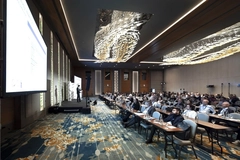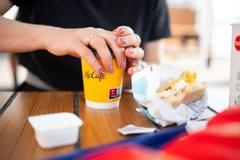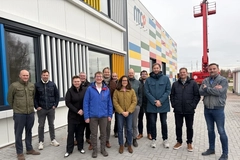Circular economy education: Packaging consultants discuss developing industry training courses

13 Aug 2024 --- Educational courses for industry professionals are becoming more common in the packaging sector as new materials, designs, technologies and legislative developments rapidly change the market. But with different adaptations hitting various global regions at different paces, training for stakeholders has to remain versatile and constantly evolving.
Richard Coles, a chemist and food scientist who has worked in the packaging sector for over 30 years, and Mike Swain, a materials scientist and industry consultant, have spent the past four years developing a program that they say can cater to packaging professionals from across the value chain, in different global regions and according to changing requirements.
Named the Packaging Design for the Circular Economy Course, the program was initially conceived in the mid-2010s, says Coles, while he was working in collaboration with the UK’s Carbon Trust consultancy firm. Together with Swain, Coles organized a meeting with Tom Leech, an industrial designer, to discuss the idea.
“By the end of the evening we had realized we all shared the same frustrations from different perspectives about how circular principles could be applied practically to the packaging world and we sketched out a plan of how we might put together our collective experiences and knowledge to develop an approach that anyone could find useful,” Swain says.
“We agreed to make a concerted effort to put some thought into this and meet up in the new year to see if this was possible. It was November 2019, and the world was about to become a very different place.”
Knowledge gaps
After the global outbreak of the COVID-19 pandemic the following month, the team began developing a plan to establish a course merging their experiences in developing circular solutions for packaging problems. “But we realized that while the underlying principles were common, the detail of how you do them was quite a different skill,” Swain says.
“We were frustrated with the lack of pragmatic information available that would take this ‘circular economy’ aspiration (as the Ellen MacArthur Foundation has engagingly expressed) and focus in on some useful and practical ways to make it happen, not overnight, but at least just get a handle on what to do about it.”
 Mike Swain, managing director of Pack IDS. “There was a gap, an area where the aspiration could be molded into tools, guidelines and approaches that could align on the principles and aspirations to make the changes needed. We started in March 2020, virtually of course, and developed a framework for the course, borne of experience and the latest industry discussions.”
Mike Swain, managing director of Pack IDS. “There was a gap, an area where the aspiration could be molded into tools, guidelines and approaches that could align on the principles and aspirations to make the changes needed. We started in March 2020, virtually of course, and developed a framework for the course, borne of experience and the latest industry discussions.”
“What we eventually developed was a course that takes attendees on a journey from what is currently the industry best practices and default approaches to a collection of tools, guidelines and pearls of wisdom that most anyone who is in the packaging industry can take something useful from and apply them to make more ‘circular’ design and specification choices.”
Course adaptability
Swain says the course is developed to “not get too deep into the detail and technicalities of packaging issues” because the principles remain the same no matter what a company is doing or working on at a given time or place.
“However, the application at the packaging design and specification level is very specific to the business, industry and regions you make and sell products in. We try to give the attendees, no matter what their role, the confidence to challenge the status quo to make change happen where needed,” he says.
The course curriculum is designed to mirror their experience as industry consultants, continues Swain. “We use our own perspectives, experiences and current work challenges and we have ‘practiced what we preach.’”
Swain says the examples from their past experiences have been so impactful that as the course has evolved and improved since its first version, they have continued to use the same examples to keep in pace with the industry and show practical, real-life examples of how circular packaging design can be implemented successfully.
Evolving the course
While the course was originally planned as a face-to-face (f2f) course over two days, the COVID-19 lockdown was enforced.
“We redesigned and updated the course for online delivery which we ran in April 2021,” Coles explains. “The online version required a completely new format which involved significant time input and it launched successfully with a cohort of 14 delegates in various industry roles who gave positive feedback and inspired its further development.”
“It was always our intention to launch a ‘Rolls Royce’ f2f version of the course in order to ensure a high level of interaction between course delegates.”
“Since then, we have delivered several blended online/f2f courses through various platforms both in the UK and EU. The course is adapted as appropriate for these different market contexts taking account of the different rapidly evolving regulatory and business landscapes.” Richard Coles, managing director of Emagine Packaging.
Richard Coles, managing director of Emagine Packaging.
Also, the course content is tailored to address audiences representing specific industry sectors, for example with F&B, toys, games and gifts, Coles adds.
Attendee success
Of the original attendees from 2021, one example — who has chosen to remain anonymous — says they “have really taken the course to heart and applied it to their role.”
“The changes made improved not only the ‘circular’ credentials of their packaging but also encouraged the business to invest in their packaging team,” Swain claims.
“The benefits seen also extended to better cost structures,” he continues, “better supplier choices and ultimately a redesign of much of the core packaging for the key profit driving items.”
“As an e-commerce based business, they have seen secondary benefits in less returns from ‘damage during transit’ items. This had very recently led to a new challenge in a new business for them, looking to make similar inroads to circular packaging design choices.”
Swain says that most previous attendees have expressed how useful it was in being able to address the business they work in with confidence and be “more assured of what they talk about, the choices they make and the changes they lead. Ultimately, the packaging they use is stepping closer to circular and striding further away from linear.”
Ownership is the key
The key challenge the team faces is keeping the course up-to-date and relevant in the changing dynamic of individual country regulations, industry activities and also what can be reported in the press, Swain says.
“We review and update the content every 3–6 months (usually dependent on the amount of government and industry activity) and this seems to keep on top of how the principles evolve more slowly with experience and application, but also expressing and putting into context the detail of the latest changes in policies, directives and laws.”
“As an industry, we need to work in a more aligned way and agree on much of the ‘how’ when we approach change. We are also not very well practiced with significant change so we need to approach this with our eyes open.”
“One of the key principles of the circular economy, and of this course, is the need for ownership and taking responsibility for what we do and the changes we make. Ownership is the key, and relying on others to make changes for us has got us in the position we are in with the linear economy.”
By Louis Gore-Langton











